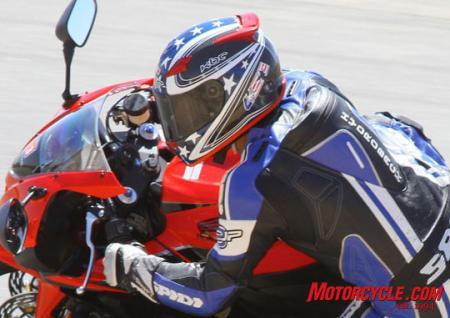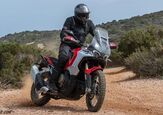2011 KBC VR4R Helmet Review
In the world of motorcycle helmets, it seems like the choices are limitless. At the upper end of the spectrum lie popular Japanese and Italian brands that are known for their fit, finish and quality. At the opposite end of the spectrum lie up-and-coming — or worse yet, fly-by-night — brands, usually made in China, that tout much more affordable prices and colorful graphics, but have zero reputation for safety.
Then somewhere in the middle you have companies like KBC, the Korean company who is establishing itself as one of the leading names in affordable helmets with an eye towards safety and functionality. Its newest model, the VR4R, is the latest example. Available in both a carbon fiber and a tri-composite shell, we were sent the former in this patriotic U.S. Olympic Replica color scheme. In case you don’t know, the American (and Canadian) Bobsled and Skeleton teams are sponsored by KBC and, in the case of the Americans, sport this exact same lid during competition.
Graphics aside, the most noticeable feature of the VR4R is its light weight. Coming in at approximately 2.85 pounds for a medium, according to KBC, it’s one of the lightest helmets I’ve ever put on my head. It’s important to note that the VR4R is ECE approved and meets D.O.T. standards, but was not put through Snell certification tests. Whether or not the European standard is sufficient is a personal choice, but if it’s good enough for Olympians, it’s good enough for me. In the case of the tri-composite shell that features carbon fiber, Kevlar and fiberglass construction, a medium version of it weighs in at about 3.15 pounds, which is still impressive.
Aside from the different shell construction both helmets feature dual-layer EPS lining with ventilation channels already integrated into the design. A “Perfect-Seal” ratcheting system helps ensure a proper closure each time the faceshield comes down. Speaking of facesheilds, the VR4R features KBC’s “One-Touch” release system that’s simple to use — simply pull and release each tab and the shield literally pops right out. Installing a new shield is equally as simple; line the shield in its top-most position and snap it into place.
Inside the helmet, a Savoir suede liner feels soft to the touch and wicks away sweat quickly. Cheekpad density is slightly firm initially, but breaks-in over time to provide what feels like a tailored fit to the individual’s face. Finer details like a chin curtain and a pull tab on the double D-ring strap closure to help facilitate helmet removal are also nice touches.
After wearing the helmet almost exclusively lately, I can say that I’m very impressed with the VR4R. Realize, too, that this is coming from someone who often criticized the company’s past models for one reason or another. Needless to say, I was skeptical from the start when evaluating this latest offering. But from the moment I took it out of the box my impressions started to shift. It was mentioned before, but its lightweight deserves repeating.
On the road the weight is hardly noticeable. Also impressive is its aerodynamic profile; cruising at highway speeds the helmet slices through the wind nicely, whether looking straight ahead or turned to the side. The chin curtain also does a good job of limiting the amount of turbulent air that comes up through the chin bar, which can potentially dry the eyes.
Though the dimensions of the eyeport aren’t particularly significant, I was pleased with the field of view above my eye brows, especially during track riding. When hanging off the side of the bike trying to clip an apex, being able to look up to the turn ahead is pretty important. Your mileage may vary, however, due to different head shapes and sizes.
As impressive as the VR4R is, there are still some sour spots worth mentioning. Ventilation from the VR4R consists of a total of five ports: an adjustable chinbar port, three across the forehead, and an integrated vent within the rear spoiler. Their mechanical operation is a step above models of yore, as each cover glides along effortlessly, but all told ventilation itself was one area that was lackluster — I couldn’t notice a difference with the vents open or closed.
Another minor complaint involves the pull tab on the double D-rings. Its position on the D-ring isn’t fixed, nor is the D-ring itself fixed to the strap. This means that both items can shift when trying to cinch the helmet on your head, especially in a hurry. Pulling on the tab to try and loosen the straps for helmet removal often did nothing, so I had to resort to manually freeing the strap from the D-ring.
All told, these are rather small gripes about an overall helmet that has changed the way I think about KBC. If this is any indication of KBC’s future, then expect big things to come. The VR4R starts at $319 for the tri-composite in solid colors, and goes up to $429 for this carbon fiber, U.S. Olympic Replica seen here. For more information, visit http://www.kbchelmet.com/.
Related Reading
KBC Super-X Helmet Review
2011 Shoei Qwest Helmet Review
Shoei RF1100 Helmet Review
2010 Arai Corsair V Helmet Review
2010 Icon Airframe Carbon Lifeform Helmet Review
Fulmer M1 Modus Flip-front Helmet Review
Scorpion EXO-700 Helmet Review
More by Troy Siahaan
































Comments
Join the conversation